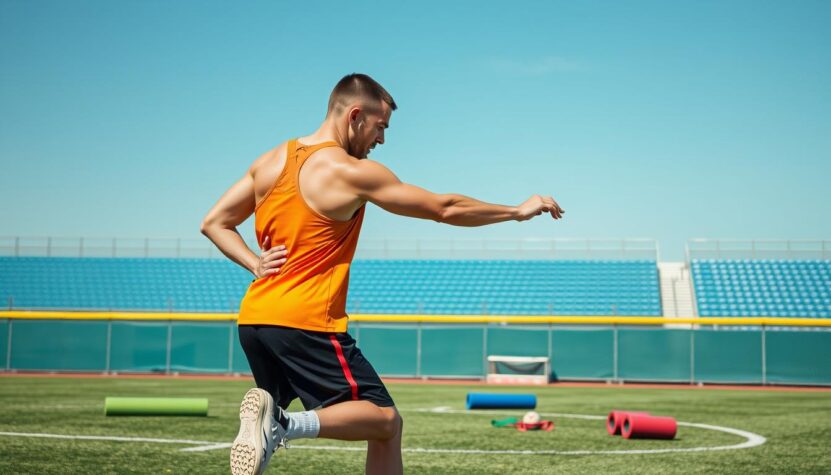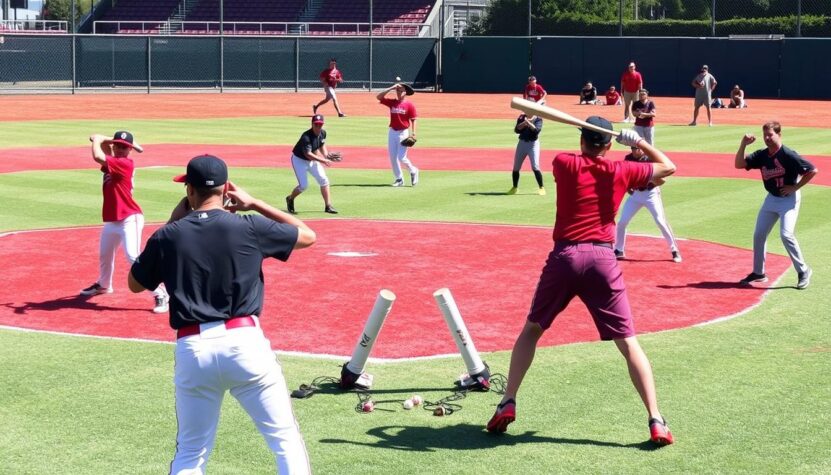In modern baseball, athleticism and conditioning are just as critical as technical skills. Whether you’re a seasoned player or a newbie, integrating the right baseball workouts into your routine can dramatically impact your performance on the field. The primary focus should be on developing strength, flexibility for baseball, and endurance to handle the rigorous demands of the sport. Here, we’ll explore tailored workout regimes for different roles – pitchers, hitters, and general conditioning applicable to all players.
Baseball involves significant side-to-side power and agility. Hence, exercises that enhance lateral movement can make a huge difference. For instance, incorporating broad jumps (4 sets of 3 jumps), side to side lateral jumps (4 sets of 2 jumps per leg), and side lunges (4 sets of 10 reps per leg) effectively boosts your game. Additionally, push-ups (4 sets of 12-15 reps) and one-leg glute bridges (4 sets of 12 reps per leg) are great for building overall strength.
Core stability is another vital component of baseball fitness. Engaging in a plank series (3 sets of 30 seconds in each position) improves your core strength. The Y-Raise/T-Raise Combo (4 sets of 12 reps for each movement) can be seamlessly added to your daily workout regime. What’s convenient about these exercises is that they can be done entirely at home without the need for specialized equipment.
For players aiming to throw farther and hit harder, focusing on leg and core strength is essential. Integrate posterior chain exercises such as deadlifts, squats, glute/ham raises, reverse hypers, and good mornings into your routine. These exercises are crucial for developing lower body power, which translates into stronger throws and hits. Moreover, rotational core workouts help connect strength training with the twisting motions integral to baseball.
In preparing pitchers, workouts should address arm and shoulder conditioning. External rotation exercises can significantly enhance the strength of your throwing arm, ensuring greater velocity and accuracy. Remember, a strong posterior chain is crucial here too. Including olympic lifting variants such as the clean & jerk and snatch will bolster not only your power but also your agility and overall athleticism.
Effective Workouts for Hitters
Maximizing hitting power is critical for a baseball player aiming to elevate their game. In hitter workouts, it’s essential to focus on various muscle groups and types of exercises that improve power, strength, and mobility. Below are key aspects of baseball strength training, designed to ensure that you can hit those home runs effortlessly.
Strength Training for Baseball Hitters
When it comes to baseball strength training, exercises like deadlifts, Bulgarian split squats, and lat pull-ups are fundamental. These exercises target the lats, hips, and core—muscle groups essential in the kinetic chain of a baseball swing. According to research by Shaffer et al., the swing is a sequence of coordinated muscle activity starting with the hips and ending with the arms. Emphasizing hip strength development significantly enhances hitting power.
Electromyography testing indicates that the lower body plays a major role in the baseball swing. Thus, focusing on strengthening the trunk and hip muscles can significantly impact your performance.
Power Development Exercises
High-impact baseball power workouts include explosive movements designed to build power and speed. Medicine ball throws, sprinting, and jumping exercises improve rotary strength and incorporate lower body muscles to enhance bat speed. Incorporating broad jumps and side-to-side lateral jumps can elevate your hitting power and overall athleticism, even for those without access to a gym.
Rotational Core Workouts
Core strength plays a crucial role in swinging a bat effectively, enabling proper rotation and power transfer. Exercises such as Russian twists, banded wood chops, and barbell Russian twists enhance rotational strength. Developing core strength and stability is key to maximizing bat speed and ensuring alignment during the swing. Additionally, exercises focusing on T-spine and hip mobility, such as mobility exercises, are vital for younger players undergoing growth spurts, as these improve the fluidity and efficiency of swings.
A structured baseball strength training program that prioritizes both strength and power will undoubtedly help you become a more effective hitter. By consistently integrating these targeted hitter workouts, you’ll notice improved performance when you’re up to bat.
Best Baseball Workouts for Pitchers
In the world of baseball, maintaining peak performance as a pitcher requires a unique approach to fitness. This section delves into pitcher workouts designed to improve strength, conditioning, speed, and injury prevention for baseball players. Emphasis on dedicated exercises ensures pitchers stay agile, powerful, and resilient against injuries. Let’s explore key components of an effective workout regimen for pitchers.
Pitcher-Specific Strength Drills
Pitchers need distinct strength training that targets their shoulder stability, arm strength, and endurance. Some of the best exercises include:
- Farmer’s Walk: 3 sets at maximum duration twice per week to enhance grip strength and overall stability.
- Single-Leg RDL: 5 sets of 8 reps each leg for power and balance.
- Deadlifts: 5 sets of 8 reps for overall body strength, focusing on the posterior chain.
Arm and Shoulder Conditioning
Effective conditioning drills are vital for maintaining pitchers’ arm health and preventing injuries. Recommended arm care exercises include:
- Band Face Pulls: 3 sets of 8 reps to strengthen shoulder muscles and reduce rotator cuff injuries.
- Side-Lying External Rotations: 3 sets of 15 reps to target specific shoulder muscles critical for pitching.
- Foam Rolling: One minute per muscle group, focusing on hips, hamstrings, biceps, and rotator cuffs, to alleviate tightness and improve flexibility.

Plyometric Training for Pitchers
Plyometric exercises incorporate speed drills to emulate the explosive movements in pitching, enhancing power and agility. Essential exercises include:
- Plyo Push-Ups: 5 sets of 8 reps to develop dynamic upper-body strength.
- Rotational Med Ball Throws: 5 sets of 8 reps on each side to improve rotational power and core stability.
- Planks: 3 sets of 30 seconds each to build core endurance and stability.
Integrating these pitcher workouts into your routine 3-4 times per week, with 2-3 sets per workout and 12-20 reps per exercise, caters to players of all ages, ensuring comprehensive conditioning and injury prevention for baseball players across different skill levels and seasons.
Conclusion
Understanding the importance of tailored baseball workouts is essential to achieve peak performance baseball. Whether you are a pitcher, hitter, or any baseball player, incorporating customized exercises that target specific muscles and movements related to your role can dramatically enhance your game. Emphasizing baseball fitness through structured routines ensures that your training is both effective and safe.
As discussed, baseball training techniques like circuit workouts offer an organized and efficient way to train large groups of up to 50 attendees. The suggested format of 6 exercises for 30 seconds each, with a 15-second rest in between, performed for 4-6 rounds, encourages a practical yet powerful approach to conditioning. This workout prioritizes simplicity and effectiveness, making it accessible to players at various skill levels.
Dynamic exercises, such as medicine ball drills and band exercises, are vital in developing explosive power and preventing common injuries, such as those involving the shoulder and elbow. Incorporating lateral hopping and sport-specific movements within your regimen can significantly improve your agility and overall strength, critical for any baseball position. Moreover, using compression sleeves can support muscle recovery and reduce soreness, mitigating the risk of injury.
When designing your baseball fitness plan, it’s crucial to consult with coaching and fitness professionals. They can help tailor your training to your individual needs, ensuring that you are applying the best baseball training techniques to enhance your performance and career longevity. By concentrating on a balance of lower body, upper body, and overall strength workouts, you’ll be well-prepared to meet the demands of peak performance baseball.

